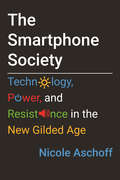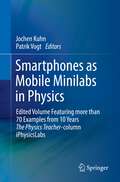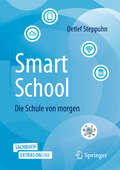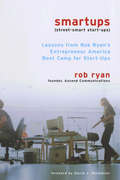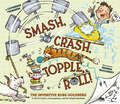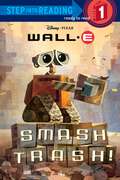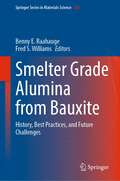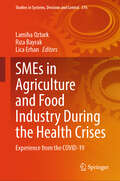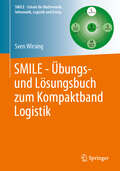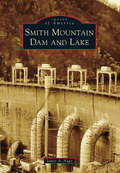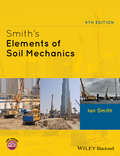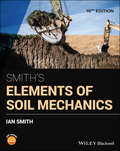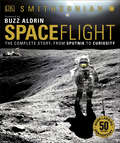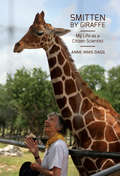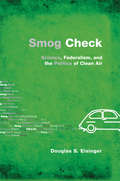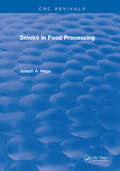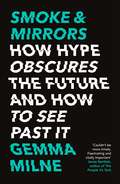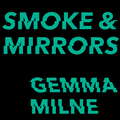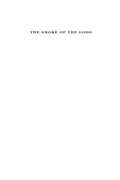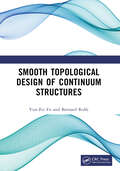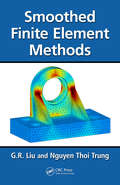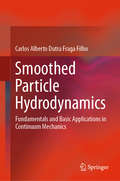- Table View
- List View
The Smartphone Society: Technology, Power, and Resistance in the New Gilded Age
by Nicole AschoffAddresses how tech empowers community organizing and protest movements to combat the systems of capitalism and data exploitation that helped drive tech's own rise to ubiquity.Our smartphones have brought digital technology into the most intimate spheres of life. It's time to take control of them, repurposing them as pathways to a democratically designed and maintained digital commons that prioritizes people over profit. Smartphones have appeared everywhere seemingly overnight: since the first iPhone was released, in 2007, the number of smartphone users has skyrocketed to over two billion. Smartphones have allowed users to connect worldwide in a way that was previously impossible, created communities across continents, and provided platforms for global justice movements. However, the rise of smartphones has led to corporations using consumers' personal data for profit, unmonitored surveillance, and digital monopolies like Google, Facebook, and Amazon that have garnered control over our social, political, and economic landscapes.But people are using their smartphones to fight back. New modes of resistance are emerging, signaling the possibility that our pocket computers could be harnessed for the benefit of people, not profit. From helping to organize protests against the US-Mexico border wall through Twitter to being used to report police brutality through Facebook Live, smartphones open a door for collective change.
Smartphones as Mobile Minilabs in Physics: Edited Volume Featuring more than 70 Examples from 10 Years The Physics Teacher-column iPhysicsLabs
by Jochen Kuhn Patrik VogtThis book presents more than 70 physics experiments from iPhysicsLabs-column of the Journal The Physics Teacher. The articles are aimed at physics lecturers, trainee teachers and teachers who want to take their classes to the next level using digital devices. The experiments can easily be performed and analyzed using smartphones or tablets. The topics span from mechanics, optics, thermodynamics, astrophysics and astronomy to acoustics, electrodynamics and electronics.Authors worldwide have contributed to this series of articles. To celebrate the 10th anniversary of iPhysicsLabs, Jochen Kuhn and Patrik Vogt have collected more than 70 most popular and interesting articles for this book.
SmartSchool - Die Schule von morgen
by Detlef SteppuhnDer technologische Wandel gewinnt rasant an Tempo – alle Schulen müssen sich dieser Herausforderung zeitnah stellen. Dieses Sachbuch erläutert, welche Technologien warum in Schulen zum Einsatz kommen müssen und welche besonderen Fortbildungs- und Supportkonzepte sie wirklich benötigen, wozu SmartTeams gebraucht werden und welche Bedeutung Robotik, KI, Virtual Reality, eSports und Wettbewerbe für den Unterricht haben. Alle Beteiligten erhalten viele Anregungen, Tipps, Ideen und Beispiele für den erfolgreichen Weg zu einer – auch, wenn viele das Wort noch scheuen – SmartSchool. Kritisch hinterfragen die Autoren, warum es (noch) keine guten digitalen Unterrichtsmaterialien gibt und warum Schulen und Schulträger intensiver zusammenarbeiten müssen. Denn SmartSchools sind die Schulen von morgen! - Mit Online-Zusatzmaterialien.
Smartups
by Rob RyanBuilding successful start-ups was never quite as easy as it seemed, and the changing economic climate has raised the stakes, reduced the margin of error. New entrepreneurs can't stumble into wealth on the power of half-formed ideas, or turn dreams into reality without doing a lot of homework. It's time to get smart. This book teaches would-be entrepreneurs the skills they need to get through the venture capital process with companies that will survive to grow and succeed. Rob Ryan, a pioneer in the high-tech industry, founded Ascend Communications in 1989, and throughout the nineties provided firms with the infrastructure they needed to keep up with the rapid growth of the Internet. At the beginning of 1999, Ascend was sold to Lucent for $25 billion. Since retiring from Ascend and starting Entrepreneur America, Ryan has helped launch a string of successful companies, including Virtmed, RightNow, and Virtual Ink. All provide electronic solutions to real-world problems, meet existing-rather than manufactured-needs, and save their customers time and money. In Smartups, Ryan focuses on methods he's developed over the years for building a sustainable business that makes money. He emphasizes the importance of testing ideas on customers and making sure that a product offers something new and important. Recognizing a team's key competencies is crucial, Ryan says. He also finds it necessary to take certain steps at the correct stages of a company's inception. Smartups will show you how to turn your idea into a real product, take it to investors, and get your start-up started right.
Smash, Crash, Topple, Roll!: The Inventive Rube Goldberg—A Life in Comics, Contraptions, and Six Simple Machines
by Catherine ThimmeshA joyfully illustrated picture book biography of Rube Goldberg for STEM-loving children and the many people who enjoy doing simple tasks the hard way.Award-winning author Catherine Thimmesh’s irresistibly engaging text and artist Shanda McCloskey’s energetic, cartoon-style artwork introduce readers to the life and creative legacy of Rube Goldberg, the world-famous inventor of crazy contraptions. A rollicking educational kids' book that is part biography, part inspiration, and part physics how-to, Smash, Crash, Topple, Roll! posits the ultimate question … why do anything the simple way? (Especially if, for instance, there is a catapult option?) Because, of course, there are lots of things you can do the simple way: Set an alarm, flip a switch, open a door, toast some bread . . . But what if, instead, you did things the Rube Goldberg way? Endlessly entertaining, needlessly complex, and achieving a delicate balance of physics, humor, and excitement! The book includes an overview of the six simple machines that power most of Goldberg’s inventions and puts the tools for making real-life Rube Goldberg machines right into readers’ hands. It’s the perfect thing to spark the imaginations of budding inventors, artists, and thinkers of all ages—because the most promising relationships with science start not with a textbook but with the willingness to break stuff and ask silly questions!SCIENCE MADE FUN: Sure to excite students, teachers, and parents looking for a playful, hands-on way to dive into the sciences and connect to STEM and STEAM efforts in schools, where Rube Goldberg machines are already in use, this book offers a fun way to approach the sometimes-daunting subject of physics. INSPIRATIONAL AWESOMENESS: There are more and better opportunities for kids to embrace and explore a love of science and engineering today, and Rube Goldberg was an artist, too! This is the perfect book to encourage the scientist and artist in every kid. POPULAR SUBJECT FOR KIDS: There are over 1 million views of various Rube Goldberg videos on YouTube featuring overly complicated ways to turn a page, pass the salt, water a plant, and more.Perfect for: Young makers Parents, grandparents, and caregivers encouraging budding engineers and artists Classroom book or gift for teachers Rube Goldberg fans of all ages
Smash Trash! (Step into Reading)
by RH DisneyMeet WALL•E in this Step 1 reader! It is the 29th Century and the Earth has been abandoned, but one robot has been left behind to collect and condense trash—WALL•E. This Step 1 Step into Reading book introduces early readers to Disney/Pixar WALL•E.
Smelter Grade Alumina from Bauxite: History, Best Practices, and Future Challenges (Springer Series in Materials Science #320)
by Benny E. Raahauge Fred S. WilliamsThis book provides a comprehensive review of the production of smelter grade alumina from bauxite ores. It emphasizes the best practices applied in the industry today but seen in a historical context with a view to future challenges and developments. The control of alumina quality is discussed in detail including the effects that alumina quality have on the aluminum smelter process with respect to environmental performance, current efficiency, and metal purity. The discussion of alumina quality will be relevant to people on the smelter side, as this is the interface between refinery and smelter. Emphasis is placed on the major steps of the Bayer Process including: digestion, clarification, precipitation, calcination, and management of water, energy, and bauxite residue. This book is a valuable resource for active, seasoned practitioners and for new engineers entering the industry.
SMEs in Agriculture and Food Industry During the Health Crises: Experience from the COVID-19 (Studies in Systems, Decision and Control #576)
by Lamiha Ozturk Rıza Bayrak Lica ErhanThis book aims to propose a suitable contingency plan that can minimize the negative effects of future health crises while strengthening the resilience and adaptability of SMEs. The starting point of this work is based on the work of the research project No. 221N283, jointly funded by TÜBİTAK and NARD. This project is part of an integrated approach from the laboratory to the market, with the aim of analyzing and promoting practical and strategic solutions for the development of SMEs in a crisis context. Following the results obtained, the scientific research team sought to broaden its scope of investigation by addressing the challenges that small and medium-sized enterprises (SMEs) face during global crises. This is a crucial issue in a context where economic sustainability and security are increasingly threatened by unforeseen events such as global epidemics.
SMILE - Übungs- und Lösungsbuch zum Kompaktband Logistik (Schule für Mathematik, Informatik, Logistik und Erfolg)
by Sven WirsingDieses Übungsbuch ergänzt den SMILE-Kompaktband mit einer Vielzahl von Übungsaufgaben und deren Lösungen. Alle im Kompaktband dargestellten Inhalte: Grundlagen, Wareneingangskontrolle, Chargenschnittstelle, Kühlguteinlagerung, GUI-Dialoge und Disposition von LKWs werden mit logistischen und mathematischen Aufgaben sowie Fragestellungen zu Python vertieft. Die Python-Lösungen sind bei Springer downloadbar. Ein besonderes Highlight ist das letzte Kapitel Szenario „Tischtennis-AG“, in dem mittels einer fiktiven Firma, die Tischtennis-AG, die wichtigsten Thematiken zu allen Kapiteln erneut als Aufgaben praxisrelevant dargestellt werden.
Smith, Currie & Hancock's Common Sense Construction Law: A Practical Guide for the Construction Professional
by John M. Mastin Eric L. Nelson Ronald G. Robey Smith, Currie & Hancock LLPThe #1 construction law guide for construction professionals Updated and expanded to reflect the most recent changes in construction law, this practical guide teaches readersthe difficult theories, principles, and established rules that regulate the construction business. It addresses the practical steps required to avoid and mitigate risks—whether the project is performed domestically or internationally, or whether it uses a traditional design-bid-build delivery system or one of the many alternative project delivery systems. Smith, Currie & Hancock's Common Sense Construction Law: A Practical Guide for the Construction Professional provides a comprehensive introduction to the important legal topics and questions affecting the construction industry today. This latest edition features: all-new coverage of Electronically Stored Information (ESI) and Integrated Project Delivery (IPD); extended information on the civil False Claims Act; and fully updated references to current AIA, ConsensusDocs, DBIA, and EJDC contract documents. Chapters coverthe legal context of construction; interpreting a contract; public-private partnerships (P3); design-build and EPC; and international construction contracts. Other topics include: management techniques to limit risks and avoid disputes; proving costs and damages, including for changes and claims for delay and disruption; construction insurance, including general liability, builders risk, professional liability, OCIP, CCIP, and OPPI; bankruptcy; federal government construction contracting; and more. Fully updated with comprehensive coverage of the significant legal topics and questions that affect the construction industry Discusses new project delivery methods including Public-Private Partnerships (P3) and Integrated Project Delivery (IPD) Presents new coverage of digital tools and processes including Electronically Stored Information (ESI) Provides extended and updated coverage of the civil False Claims Act as it relates to government construction contracting Filled with checklists, sample forms, and summary “Points to Remember” for each chapter, Smith, Currie & Hancock's Common Sense Construction Law: A Practical Guide for the Construction Professional, Sixth Edition is the perfect resource for construction firm managers, contractors, subcontractors, architects and engineers. It will also greatly benefit students in construction management, civil engineering, and architecture.
Smith Mountain Dam and Lake (Images of America)
by James A. NagyThe construction of a dam in the gap of Smith Mountain in Pittsylvania County, Virginia, had been considered as early as the 1920s. However, the dam's construction did not begin until 1960. Smith Mountain Dam closed the gap completely in 1963, and Smith Mountain Lake began to fill and form behind it. The hydroelectric dam consists of 175,000 cubic yards of concrete and has the capacity to generate 605 megawatts of electricity for up to 11 hours. Smith Mountain Dam is part of a two-dam system on the Roanoke River, and its companion dam, the Leesville Dam, is a smaller structure designed to pump water back to Smith Mountain Lake and to also generate hydroelectric power for American Electric Power (AEP) customers. Smith Mountain Lake covers 20,000 acres and has a 500-mile shoreline, which borders Franklin, Pittsylvania, and Bedford Counties. Over the years, development near and around Smith Mountain Lake has exploded, and this has presented both opportunities and challenges in regard to stewardship of the area's natural resources.
Smith's Elements of Soil Mechanics
by Ian SmithThe 9th edition maintains the content on all soil mechanics subject areas - groundwater flow, soil physical properties, stresses, shear strength, consolidation and settlement, slope stability, retaining walls, shallow and deep foundations, highways, site investigation - but has been expanded to include a detailed explanation of how to use Eurocode 7 for geotechnical design. The key change in this new edition is the expansion of the content covering Geotechnical Design to Eurocode 7. Redundant material relating to the now defunct British Standards - no longer referred to in degree teaching - has been removed. Building on the success of the earlier editions, this 9th edition of Smith’s Elements of Soil Mechanics brings additional material on geotechnical design to Eurocode 7 in an understandable format. Many worked examples are included to illustrate the processes for performing design to this European standard. Significant updates throughout the book have been made to reflect other developments in procedures and practices in the construction and site investigation industries. More worked examples and many new figures have been provided throughout. The illustrations have been improved and the new design and layout of the pages give a lift. unique content to illustrate the use of Eurocode 7 with essential guidance on how to use the now fully published code clear content and well-organised structure takes complicated theories and processes and presents them in easy-to-understand formats book's website offers examples and downloads to further understanding of the use of Eurocode 7 www.wiley.com/go/smith/soil
Smith's Elements of Soil Mechanics
by Ian SmithSmith’s Elements of Soil Mechanics The revised 10th edition of the core textbook on soil mechanics The revised and updated edition of Smith’s Elements of Soil Mechanics continues to offer a core undergraduate textbook on soil mechanics. The author, a noted expert in geotechnical engineering, reviews all aspects of soil mechanics and provides a detailed explanation of how to use both the current and the next versions of Eurocode 7 for geotechnical design. Comprehensive in scope, the book includes accessible explanations, helpful illustrations, and worked examples and covers a wide range of topics including slope stability, retaining walls and shallow and deep foundations. The text is updated throughout to include additional material and more worked examples that clearly illustrate the processes for performing testing and design to the new European standards. In addition, the book’s accessible format provides the information needed to understand how to use the first and second generations of Eurocode 7 for geotechnical design. The second generation of this key design code has seen a major revision and the author explains the new methodology well, and has provided many worked examples to illustrate the design procedures. The new edition also contains a new chapter on constitutive modeling in geomechanics and updated information on the strength of soils, highway design and laboratory and field testing. This important text: Includes updated content throughout with a new chapter on constitutive modeling Provides explanation on geotechnical design to the new version of Eurocode 7 Presents enhanced information on laboratory and field testing and the new approach to pavement foundation design Provides learning outcomes, real-life examples, and self-learning exercises within each chapter Offers a companion website with downloadable video tutorials, animations, spreadsheets and additional teaching materials Written for students of civil engineering and geotechnical engineering, Smith’s Elements of Soil Mechanics, 10th Edition covers the fundamental changes in the ethos of geotechnical design advocated in the Eurocode 7.
Smithsonian: The Complete Story from Sputnik to Curiousity (DK Definitive Visual Histories)
by Giles SparrowThis compelling story of exploration charts and celebrates humankind in space, from Sputnik's launch in 1957 through the Apollo Moon landings and the International Space Station to future missions to Mars and beyond.Spaceflight chronicles how, in the half-century that followed Sputnik, the world was revolutionized by space travel and exploration. The opening up of Earth's orbit to satellites led to a revolution in communications, monitoring of the environment, and materials science. For the human imagination, the impact has been even greater: the voyages of robotic space probes have transformed our view of the Solar System, while Earth-orbiting satellites and missions to the Moon have forever changed our view of ourselves. This book is a celebration of human ingenuity and imagination. From the work of pioneers like Wernher von Braun, Yuri Gagarin, and Neil Armstrong to the triumphs and tragedies that followed, it reveals the people, science, and technology that have propelled us into the Space Age.
Smitten by Giraffe: My Life as a Citizen Scientist
by Anne DaggWhen Anne Innis saw her first giraffe at the age of three, she was smitten. She knew she had to learn more about this marvelous animal. Twenty years later, now a trained zoologist, she set off alone to Africa to study the behaviour of giraffe in the wild. Subsequently, Jane Goodall and Dian Fossey would be driven by a similar devotion to study the behaviour of wild apes. In Smitten by Giraffe, the noted feminist reflects on her scientific work as well as the leading role she has played in numerous activist campaigns. On returning home to Canada, Anne married physicist Ian Dagg, had three children, published a number of scientific papers, taught at several local universities, and in 1967 earned her PhD in biology at the University of Waterloo. Dagg was continually frustrated in her efforts to secure a position as a tenured professor despite her many publications and exemplary teaching record. Finally she opted instead to pursue her research as an independent "citizen scientist," while working part-time as an academic advisor. Dagg would spend many years fighting against the marginalization of women in the arts and sciences. Boldly documenting widespread sexism in universities while also discussing Dagg's involvement with important zoological topics such as homosexuality, infanticide, sociobiology, and taxonomy, Smitten by Giraffe offers an inside perspective on the workings of scientific research and debate, the history of academia, and the rise of second-wave feminism.
Smitten by Giraffe: My Life as a Citizen Scientist (Footprints Series #28)
by Anne Innis DaggWhen Anne Innis saw her first giraffe at the age of three, she was smitten. She knew she had to learn more about this marvelous animal. Twenty years later, now a trained zoologist, she set off alone to Africa to study the behaviour of giraffe in the wild. Subsequently, Jane Goodall and Dian Fossey would be driven by a similar devotion to study the behaviour of wild apes. In Smitten by Giraffe, the noted feminist reflects on her scientific work as well as the leading role she has played in numerous activist campaigns. On returning home to Canada, Anne married physicist Ian Dagg, had three children, published a number of scientific papers, taught at several local universities, and in 1967 earned her PhD in biology at the University of Waterloo. Dagg was continually frustrated in her efforts to secure a position as a tenured professor despite her many publications and exemplary teaching record. Finally she opted instead to pursue her research as an independent “citizen scientist,” while working part-time as an academic advisor. Dagg would spend many years fighting against the marginalization of women in the arts and sciences. Boldly documenting widespread sexism in universities while also discussing Dagg’s involvement with important zoological topics such as homosexuality, infanticide, sociobiology, and taxonomy, Smitten by Giraffe offers an inside perspective on the workings of scientific research and debate, the history of academia, and the rise of second-wave feminism.
Smog Check: "Science, Federalism, and the Politics of Clean Air"
by Douglas S. EisingerWhen federal and state governments battle over environmental regulations, whose approach should prevail? Shortly after passage of the 1990 Clean Air Act Amendments, a controversial U.S. EPA mandate led to an intense conflict between federal regulators and California politicians. The disagreement pitted EPA's required overhaul of auto inspections against California's desire to self-govern its test program - popularly called 'Smog Check.' The conflict nearly upended the Clean Air Act, and triggered dramatic policy shifts throughout the United States. Smog Check presents these struggles in first-hand detail. Eisinger, an EPA official at the time of this conflict, probes deeply into the issues and explores broader questions including: when does it become imperative for agencies to bargain with one another, when should regulatory flexibility and performance-based regulations be favored over command and control approaches, and what should be done when decisions need to be made in the face of scientific disagreement? The book also includes insightful commentary from other EPA participants in the Smog Check controversy. Smog Check's lessons will be relevant to climate change, air pollution control, and numerous other policy challenges.
Smoke in Food Processing
by Joseph A. MagaSmoking was one of the first forms of food processing, and through the centuries the chemistry of smoke has slowly evolved.It is now known that wood and food composition can significantly influence smoke composition, as well as the resulting textual, sensory, nutritional, antioxidative, and antimicrobial properties of the smoked food.Aside from beneficial properties, one must also consider potential health concerns associated with certain woods and their resulting smoke.
Smoke & Mirrors: How Hype Obscures the Future and How to See Past It
by Gemma Milne'Stop following the news until you've read Gemma Milne's persuasive analysis of the hype and bullshit that distort our understanding of emerging science. As she shows, the starting point to grasping the genuine opportunities of AI, life sciences and climate tech is a healthy dose of critical thinking'David Rowan, founding editor of WIRED UK and author of Non-Bullshit Innovation: Radical Ideas from the World's Smartest Minds'Couldn't be more timely. Fascinating and vitally important'Jamie Bartlett, author of The People Vs Tech'A much-needed blast of fresh air! Gemma Milne expertly shows us how to separate the truth from the hype surrounding the emerging techs of today, and those of the near-tomorrow'Lewis Dartnell, author of Origins: How the Earth Made Us'I loved this book! This is exactly the sort of sceptical, cut-through-the crap-but-still-excited-about-what's-emerging book around tech innovation that's sorely needed, yet is so hard to find . . . essential reading for anyone who's serious about how real-world advances might be effectively harnessed to build a better future'Dr Andrew Maynard, scientist and author of Films from the Future and Future Rising'[A] vital contribution in a world where technological progress promises so much, but too often disappoints. If, like me, you believe that advances in science and technology are our best hope for solving the grand challenges of our times, this book is the indispensable guide to avoiding the mirages and the charlatans along the way'Matt Clifford, co-founder and CEO of Entrepreneur First'A refreshingly grown-up, clear-headed look at the interaction between science, technology and the media - readable without being dumbed down, acknowledging complexities without being heavy'Tom Chivers, author of The AI Does Not Hate You'ROBOTS WILL STEAL YOUR JOB!''AI WILL REVOLUTIONISE FARMING!''GENETIC EDITING WILL CURE CANCER!'Bombastic headlines about science and technology are nothing new. To cut through the constant stream of information and misinformation on social media, or grab the attention of investors, or convince governments to take notice, strident headlines or bold claims seem necessary to give complex, nuanced information some wow factor.But hype has a dark side, too.It can mislead. It can distract. It can blinker us from seeing what is actually going on.From AI, quantum computing and brain implants, to cancer drugs, future foods and fusion energy, science and technology journalist Gemma Milne reveals hype to be responsible for fundamentally misdirecting or even derailing crucial progress.Hype can be combated and discounted, though, if you're able to see exactly where, how and why it is being deployed.This book is your guide to doing just that.
Smoke & Mirrors: How Hype Obscures the Future and How to See Past It
by Gemma Milne'Stop following the news until you've read Gemma Milne's persuasive analysis of the hype and bullshit that distort our understanding of emerging science. As she shows, the starting point to grasping the genuine opportunities of AI, life sciences and climate tech is a healthy dose of critical thinking'David Rowan, founding editor of WIRED UK and author of Non-Bullshit Innovation: Radical Ideas from the World's Smartest Minds'Couldn't be more timely. Fascinating and vitally important'Jamie Bartlett, author of The People Vs Tech'A much-needed blast of fresh air! Gemma Milne expertly shows us how to separate the truth from the hype surrounding the emerging techs of today, and those of the near-tomorrow'Lewis Dartnell, author of Origins: How the Earth Made Us'I loved this book! This is exactly the sort of sceptical, cut-through-the crap-but-still-excited-about-what's-emerging book around tech innovation that's sorely needed, yet is so hard to find . . . essential reading for anyone who's serious about how real-world advances might be effectively harnessed to build a better future'Dr Andrew Maynard, scientist and author of Films from the Future and Future Rising'[A] vital contribution in a world where technological progress promises so much, but too often disappoints. If, like me, you believe that advances in science and technology are our best hope for solving the grand challenges of our times, this book is the indispensable guide to avoiding the mirages and the charlatans along the way'Matt Clifford, co-founder and CEO of Entrepreneur First'A refreshingly grown-up, clear-headed look at the interaction between science, technology and the media - readable without being dumbed down, acknowledging complexities without being heavy'Tom Chivers, author of The AI Does Not Hate You'ROBOTS WILL STEAL YOUR JOB!''AI WILL REVOLUTIONISE FARMING!''GENETIC EDITING WILL CURE CANCER!'Bombastic headlines about science and technology are nothing new. To cut through the constant stream of information and misinformation on social media, or grab the attention of investors, or convince governments to take notice, strident headlines or bold claims seem necessary to give complex, nuanced information some wow factor.But hype has a dark side, too.It can mislead. It can distract. It can blinker us from seeing what is actually going on.From AI, quantum computing and brain implants, to cancer drugs, future foods and fusion energy, science and technology journalist Gemma Milne reveals hype to be responsible for fundamentally misdirecting or even derailing crucial progress.Hype can be combated and discounted, though, if you're able to see exactly where, how and why it is being deployed.This book is your guide to doing just that.
Smoke & Mirrors: How Hype Obscures the Future and How to See Past It
by Gemma Milne'Stop following the news until you've read Gemma Milne's persuasive analysis of the hype and bullshit that distort our understanding of emerging science. As she shows, the starting point to grasping the genuine opportunities of AI, life sciences and climate tech is a healthy dose of critical thinking'David Rowan, founding editor of WIRED UK and author of Non-Bullshit Innovation: Radical Ideas from the World's Smartest Minds'Couldn't be more timely. Fascinating and vitally important'Jamie Bartlett, author of The People Vs Tech'A much-needed blast of fresh air! Gemma Milne expertly shows us how to separate the truth from the hype surrounding the emerging techs of today, and those of the near-tomorrow'Lewis Dartnell, author of Origins: How the Earth Made Us'I loved this book! This is exactly the sort of sceptical, cut-through-the crap-but-still-excited-about-what's-emerging book around tech innovation that's sorely needed, yet is so hard to find . . . essential reading for anyone who's serious about how real-world advances might be effectively harnessed to build a better future'Dr Andrew Maynard, scientist and author of Films from the Future and Future Rising'[A] vital contribution in a world where technological progress promises so much, but too often disappoints. If, like me, you believe that advances in science and technology are our best hope for solving the grand challenges of our times, this book is the indispensable guide to avoiding the mirages and the charlatans along the way'Matt Clifford, co-founder and CEO of Entrepreneur First'A refreshingly grown-up, clear-headed look at the interaction between science, technology and the media - readable without being dumbed down, acknowledging complexities without being heavy'Tom Chivers, author of The AI Does Not Hate You'ROBOTS WILL STEAL YOUR JOB!''AI WILL REVOLUTIONISE FARMING!''GENETIC EDITING WILL CURE CANCER!'Bombastic headlines about science and technology are nothing new. To cut through the constant stream of information and misinformation on social media, or grab the attention of investors, or convince governments to take notice, strident headlines or bold claims seem necessary to give complex, nuanced information some wow factor.But hype has a dark side, too.It can mislead. It can distract. It can blinker us from seeing what is actually going on.From AI, quantum computing and brain implants, to cancer drugs, future foods and fusion energy, science and technology journalist Gemma Milne reveals hype to be responsible for fundamentally misdirecting or even derailing crucial progress.Hype can be combated and discounted, though, if you're able to see exactly where, how and why it is being deployed.This book is your guide to doing just that.
The Smoke of the Gods: A Social History of Tobacco
by Eric Burns"Fox News Watch" host Eric Burns, who chronicled the social history of alcohol in The Spirits of America turns to tobacco in The Smoke of the Gods. Ranging from ancient times to the present day, The Smoke of the Gods is a lively history of tobacco, especially in the United States. Although tobacco use is controversial in the U. S. today, Burns reminds us that this was not always the case. For centuries tobacco was generally thought to have medicinal and even spiritual value. Most of the signers of the Declaration of Independence were tobacco users or growers, or both. According to Burns, tobacco changed the very course of U. S. history, because its discovery caused the British to support Jamestown, its struggling New World colony. An entertaining and informative look at a subject that makes daily news headlines, The Smoke of the Gods is a history that is, well, quite addictive.
Smooth Topological Design of Continuum Structures
by Yun-Fei Fu Bernard RolfeSmooth Topological Design of Continuum Structures focuses on the use of a newly-proposed topology algorithm for structural optimization called Smooth-Edged Material Distribution for Optimizing Topology (SEMDOT).The book presents the basic theory of SEMDOT and explains connections between this method and the corresponding optimizers. The method is used to address the long-standing jagged edge problem facing classical topology optimization algorithms and is presented as a perfect tool for combining additive manufacturing and topology optimization, which are increasingly coupled together to produce new part designs. A range of representative case studies are also included to illustrate applications.This serves as a textbook and reference for graduate and senior undergraduate students in the area, as well as engineers in the structural optimization field. Full modifiable MATLAB codes for each chapter are available online.
Smoothed Finite Element Methods
by G.R. Liu Nguyen TrungGenerating a quality finite element mesh is difficult and often very time-consuming. Mesh-free methods operations can also be complicated and quite costly in terms of computational effort and resources. Developed by the authors and their colleagues, the smoothed finite element method (S-FEM) only requires a triangular/tetrahedral mesh to achieve mo
Smoothed Particle Hydrodynamics: Fundamentals and Basic Applications in Continuum Mechanics
by Carlos Alberto Dutra Fraga FilhoThis book is based on results obtained over a decade of study and research. It questions the use of dynamic molecular models in the continuum scale providing alternative solutions to open problems in the literature. It provides a physical-mathematical understanding of the differential equations that govern fluid flow and energy transport, serving as a reference to the application of Smoothed Particle Hydrodynamics in continuum fluid mechanics and transport phenomena. The physical-mathematical modelling of the problems in the continuum scale and the employment of the SPH method for solving the equations are presented. Examples of applications in continuum fluid mechanics with numerical results and discussions are also provided. This literature defends the concepts of continuum mechanics and the application of boundary treatment techniques that do not violate the laws of physics.
